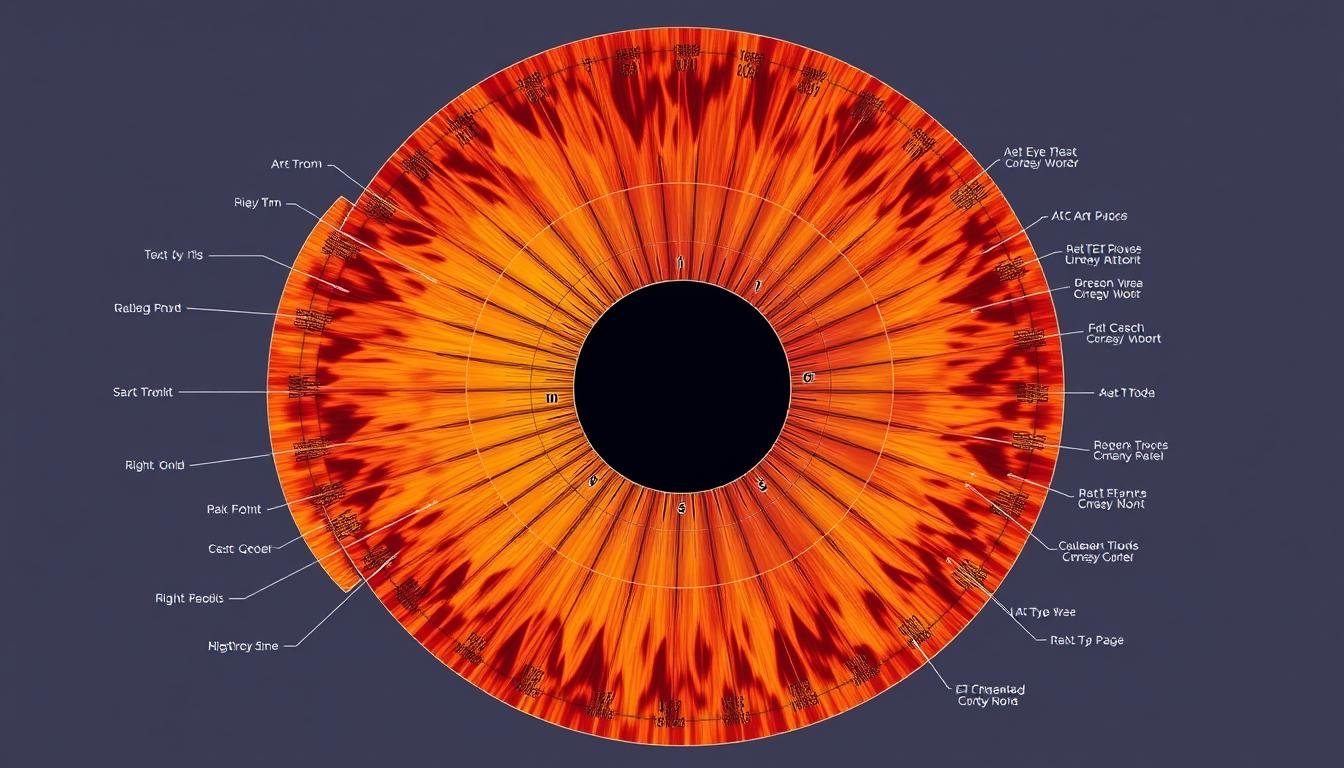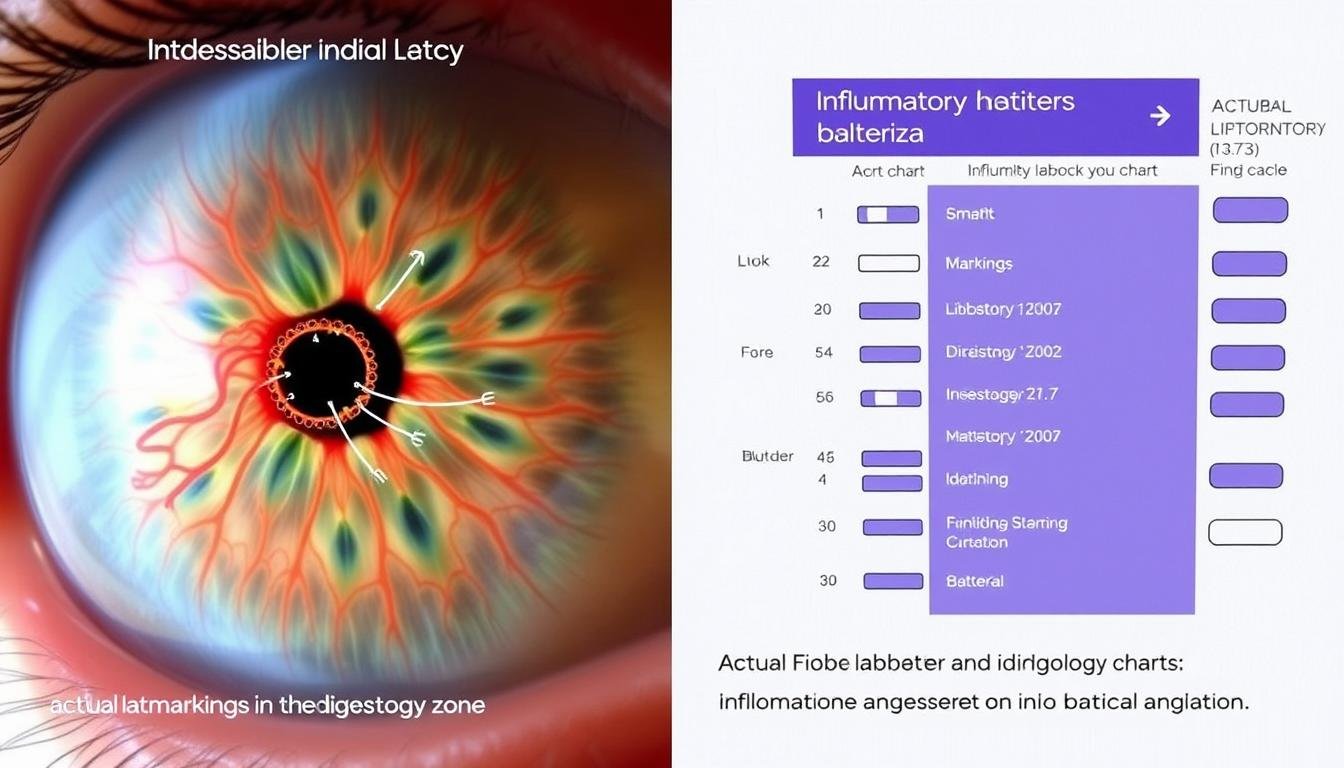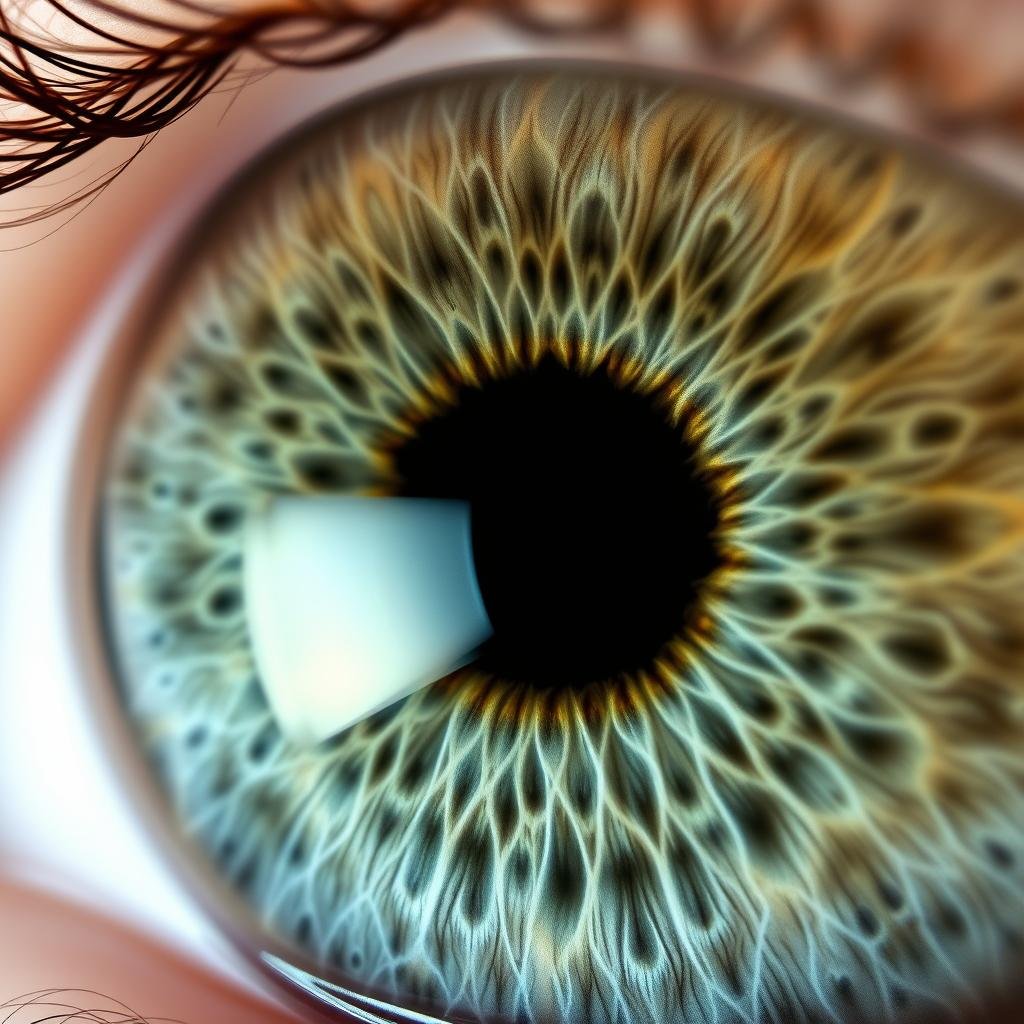The human eye has long fascinated both medical professionals and alternative health practitioners. Beyond its primary function of vision, some believe the eye—particularly the iris—can reveal insights about our overall health. Iridology charts are tools used to interpret patterns, colors, and markings in the iris, potentially identifying health conditions before symptoms appear. But how do these alternative diagnostic methods compare to conventional medical tests? This comprehensive guide explores the key differences, applications, and limitations of both approaches to help you make informed decisions about your health assessment options.



What Is an Gráfico de Iridologia?
Um gráfico de iridologia is a diagnostic tool that maps different zones of the iris to specific organs and systems within the body. Practitioners of iridology believe that the iris, the colored part of the eye, contains information about a person’s health status and potential vulnerabilities. These charts serve as reference guides to interpret various markings, colors, and patterns observed in the iris.
The History of Gráfico de Iridologia Análise
The practice of iridology dates back to the 17th century, but it was Hungarian physician Ignatz von Peczely who is often credited with developing the first comprehensive gráfico de iridologia in the 1800s. The story goes that as a child, von Peczely noticed changes in an owl’s iris after the bird suffered a broken leg. This observation sparked his interest in the connection between iris markings and physical conditions, leading him to develop detailed iris maps that linked specific areas to different body parts.
Throughout the 20th century, iridology gained popularity in Europe and later spread to North America. Dr. Bernard Jensen further refined these charts in the United States, creating what many consider the standard reference for modern iridology practice. Today, various versions of gráficos de iridologia exist, though they all share the fundamental concept of dividing the iris into zones that correspond to different organs and systems.
Como Gráficos de Iridologia Are Interpreted
Iridologistas use specialized equipment, typically high-resolution cameras and magnifying tools, to examine the intricate details of the iris. The examination process involves comparing the patient’s iris to an gráfico de iridologia to identify potential health concerns based on various markers:
- Variações de cores – Different hues within the iris may indicate various conditions or tendencies
- Fibers and structures – The arrangement and density of iris fibers are analyzed for signs of strength or weakness
- Spots and markings – Dark spots, white areas, or rings may suggest specific health issues
- Zones and positions – The location of markings is mapped to corresponding body areas using the chart
According to iridology practitioners, the right iris corresponds to the right side of the body, while the left iris reflects the left side. The chart typically divides each iris into numerous sections, with the pupil at the center representing the stomach and digestive system, and the outer edges corresponding to the skin, lymphatic system, and extremities.
Curioso sobre o que sua íris revela?
Understanding iridology charts requires professional interpretation. Consider consulting with a qualified practitioner who can provide personalized insights about your iris patterns.
Find an Iridology Specialist
Gráfico de Iridologia vs Modern Medical Testing: Core Differences
While both gráficos de iridologia and conventional medical tests aim to assess health status, they differ fundamentally in their approach, methodology, and scientific acceptance. Understanding these differences is crucial for anyone considering alternative health assessments alongside traditional medical care.
Methodology: Subjective vs Objective Analysis
The most significant difference between iridologia and conventional medicine lies in their methodological approaches:
| Aspecto |
Iridology Chart Analysis |
Medical Testing |
| Basis of Assessment |
Visual examination of iris patterns |
Measurable biological markers and parameters |
| Data Collection |
Observation and interpretation |
Quantitative sampling and analysis |
| Standardization |
Varies between practitioners |
Standardized protocols and reference ranges |
| Repeatability |
May vary with different practitioners |
Generally consistent across different labs |
| Foco |
Holistic health assessment |
Specific disease identification |
Medical tests typically measure specific parameters with defined reference ranges, while iridology relies on the practitioner’s interpretation of iris patterns according to an gráfico de iridologia. This fundamental difference affects how results are obtained, interpreted, and applied to health decisions.
Scientific Validation of Gráficos de Iridologia
The scientific community has extensively studied conventional medical tests, establishing their sensitivity, specificity, and clinical utility through rigorous research. In contrast, iridology has undergone limited scientific validation:
Medical Testing Scientific Support
- Extensive peer-reviewed research
- Established clinical validation protocols
- Quantifiable accuracy and reliability metrics
- Standardized methodologies
- Regulatory oversight and approval processes
Iridology Scientific Challenges
- Limited peer-reviewed studies
- Inconsistent results in controlled trials
- Difficulty establishing clear cause-effect relationships
- Lack of standardized diagnostic criteria
- Minimal regulatory oversight
A notable study published in the Journal of the American Medical Association tested the ability of iridologists to detect gallbladder disease using iris examinations. The study found that iridology did not perform better than chance in identifying patients with confirmed gallbladder conditions. Similar studies have questioned the diagnostic accuracy of gráficos de iridologia for detecting specific diseases.
When to Use an Gráfico de Iridologia vs Clinical Diagnostics
Understanding the appropriate applications for both iridology and conventional medical testing can help you make informed decisions about your health assessment options. While these approaches differ significantly, they may serve different purposes in a comprehensive health strategy.
Potential Applications for Iridology
- Holistic health assessment – Getting a general overview of potential body weaknesses
- Complementary insights – Adding another perspective to existing health information
- Preventive guidance – Identifying areas that might benefit from lifestyle modifications
- Personal interest – Exploring alternative perspectives on health patterns
Appropriate Uses for Medical Testing
- Diagnóstico da doença – Confirming or ruling out specific medical conditions
- Treatment monitoring – Tracking response to medical interventions
- Screening – Early detection of diseases in at-risk populations
- Emergency situations – Rapid assessment of acute health problems
Limitations of Gráfico de Iridologia Evaluations
While some find value in iridology assessments, it’s important to recognize their limitations:
Key limitations of iridology include:
- Cannot diagnose specific diseases with proven accuracy
- Lacks standardized interpretation protocols across practitioners
- May delay proper medical treatment if relied upon exclusively
- Cannot detect acute or emergency conditions reliably
- Does not measure specific biological markers or parameters
Complementary Approaches to Health Assessment
Many health-conscious individuals find value in combining different assessment methods for a more comprehensive understanding of their health status:
“The most effective approach to health often integrates multiple perspectives. While conventional medicine excels at diagnosing and treating specific conditions, complementary approaches like iridology may offer additional insights into overall patterns and tendencies.”
– Dr. Sarah Chen, Integrative Medicine Specialist
A balanced approach might include regular medical check-ups and appropriate screening tests while exploring complementary assessments like iridology as additional sources of information. The key is to maintain open communication with healthcare providers about all health approaches you’re pursuing.
Need Professional Guidance?
Considering both conventional and complementary health assessments? Speak with a healthcare provider who understands integrative approaches.
Find an Integrative Health Specialist
Estudos de caso: Gráfico de Iridologia vs Lab Results
Examining real-world examples can help illustrate the practical differences between iridology assessments and conventional medical testing. The following case studies highlight how these approaches may yield different insights.
Estudo de caso 1: Avaliação de Saúde Digestiva
Patient Profile: 42-year-old female with recurring digestive discomfort
Iridology Assessment: Analysis using an gráfico de iridologia revealed brown spots in the digestive zone of the iris, suggesting potential liver congestion and intestinal inflammation according to iridology principles.
Medical Testing: Blood tests showed normal liver enzymes but elevated inflammatory markers. Stool analysis identified a bacterial imbalance and mild food sensitivities.
Resultado: While the iridology assessment suggested general digestive system stress, the medical tests provided specific information about the nature of the inflammation and its likely causes, leading to a targeted treatment plan.


Case Study 2: Cardiovascular Health Screening
Patient Profile: 58-year-old male with family history of heart disease
Iridology Assessment: Examination using an gráfico de iridologia showed a ring around the iris (known as arcus senilis in conventional medicine) and certain markings in the heart zone, which the iridologist interpreted as signs of cardiovascular stress.
Medical Testing: Lipid panel revealed elevated LDL cholesterol and triglycerides. Blood pressure measurement showed stage 1 hypertension. ECG was normal.
Resultado: Both approaches identified potential cardiovascular concerns, but the medical tests provided quantifiable data that could be used to develop a specific treatment plan and monitor progress over time.
These case studies demonstrate that while iridology may sometimes identify areas of concern that align with medical findings, conventional testing typically provides more specific, measurable information that can guide treatment decisions and monitor outcomes.
Expert Opinions on Gráfico de Iridologia Confiabilidade
The medical and scientific communities hold varying perspectives on the validity and utility of iridology as a diagnostic tool. Understanding these viewpoints can help you evaluate iridology’s potential role in your health journey.
“While iridology hasn’t been validated by rigorous scientific studies, some patients find value in its holistic perspective. The key is to use it as a complementary tool rather than a replacement for evidence-based medical diagnostics.”
– Dr. Michael Rosen, MD, Integrative Medicine
“The patterns in the iris are fascinating, but current research doesn’t support using iridology charts for specific disease diagnosis. We need to be honest about these limitations while respecting patients’ interest in diverse health approaches.”
– Dr. Emily Winters, PhD, Medical Research
Professional medical organizations, including the American Academy of Ophthalmology, do not recognize iridology as a valid diagnostic method due to insufficient scientific evidence. However, some integrative health practitioners believe iridology can provide valuable insights when used as part of a comprehensive health assessment approach rather than as a standalone diagnostic tool.
Key Consensus Points Among Health Professionals:
- Iridology should not replace conventional medical diagnosis
- Medical tests remain essential for diagnosing specific conditions
- Patients should disclose all health approaches to their primary care providers
- Critical evaluation of all health information is important
- An integrative approach may combine insights from multiple sources
FAQs About Gráficos de Iridologia
Many people have questions about iridology and how it compares to conventional medical testing. Here are answers to some frequently asked questions to help clarify this alternative health assessment method.
Can an gráfico de iridologia detect serious diseases like cancer?
No, iridology has not been scientifically validated as a method for detecting specific diseases like cancer. While practitioners may identify patterns they associate with general tissue inflammation or stress, these observations should never replace proper medical screening and diagnostic tests for cancer or other serious conditions.
How much does an iridology assessment typically cost compared to medical tests?
Iridology assessments generally range from $50-$200, depending on the practitioner’s experience and the depth of analysis. Conventional medical tests vary widely in cost—from $10-$50 for basic blood work to thousands for advanced imaging—though these are often partially covered by health insurance, unlike most iridology sessions.
Do iris patterns change over time to reflect health changes?
According to iridology theory, certain aspects of the iris can change to reflect health status, particularly in terms of color and small markings. However, the basic structure and major patterns of the iris are generally considered fixed from birth. Scientific research has not confirmed that iris changes reliably correspond to specific health changes.
Are gráficos de iridologia the same worldwide?
No, there are several different iridology chart systems used around the world. While they share fundamental principles, charts may vary in how they divide the iris and which body systems they associate with specific zones. This lack of standardization is one criticism of iridology from the scientific community.
Can iridology predict future health problems?
Iridology practitioners sometimes claim that iris analysis can identify predispositions or weaknesses that might develop into health problems later. However, there is no scientific evidence supporting iridology as a reliable predictive tool for future health conditions. Conventional genetic testing and family history analysis provide more validated approaches to assessing health risks.

Making Informed Decisions About Health Assessment Methods
When considering different approaches to health assessment, including gráficos de iridologia and conventional medical testing, it’s important to make decisions based on balanced information and personal health goals.
Conventional medical tests offer scientifically validated methods for diagnosing specific conditions, monitoring treatment effectiveness, and screening for diseases. They provide objective, measurable data that forms the foundation of evidence-based healthcare. Iridology, while intriguing to many as a holistic assessment tool, lacks the same level of scientific validation and standardization.
A thoughtful approach might involve maintaining regular medical care while exploring complementary perspectives like iridology if they align with your health philosophy. The key is to maintain open communication with healthcare providers about all approaches you’re pursuing and to prioritize evidence-based care for specific health concerns.
Remember that your health journey is personal, and the approaches that work best for you may combine insights from various traditions while prioritizing safety and effectiveness. By staying informed about the strengths and limitations of different assessment methods, you can make choices that support your overall wellbeing.
Ready to Explore Your Health Assessment Options?
Speak with a healthcare provider who can help you navigate both conventional and complementary approaches to understanding your health.
Schedule a Consultation Today

























